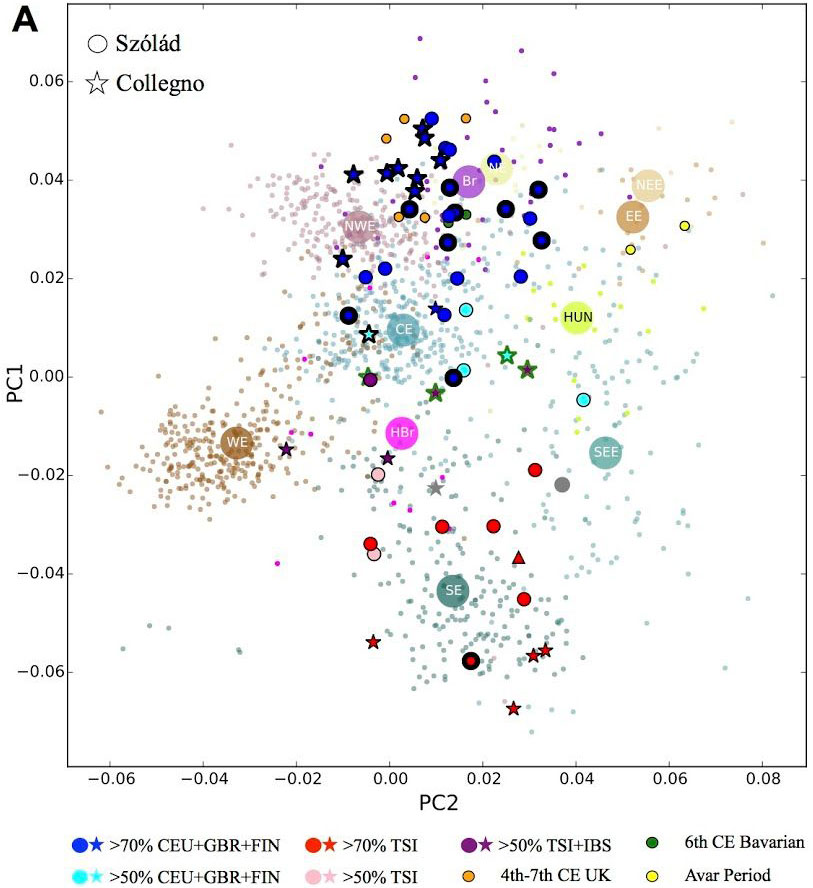New preprint at BioRxiv, Understanding 6th-Century Barbarian Social Organization and Migration through Paleogenomics, by Amorim, Vai, Posth, et al. (2018)
Abstract (emphasis mine):
Despite centuries of research, much about the barbarian migrations that took place between the fourth and sixth centuries in Europe remains hotly debated. To better understand this key era that marks the dawn of modern European societies, we obtained ancient genomic DNA from 63 samples from two cemeteries (from Hungary and Northern Italy) that have been previously associated with the Longobards, a barbarian people that ruled large parts of Italy for over 200 years after invading from Pannonia in 568 CE. Our dense cemetery-based sampling revealed that each cemetery was primarily organized around one large pedigree, suggesting that biological relationships played an important role in these early Medieval societies. Moreover, we identified genetic structure in each cemetery involving at least two groups with different ancestry that were very distinct in terms of their funerary customs. Finally, our data was consistent with the proposed long-distance migration from Pannonia to Northern Italy.
Interesting excerpts:
Since the adults were almost all non-local, it is tempting to suggest that we may be observing the historically described fara during migration. Regardless, this group appears to be a unit organized around one high-status, kin-based group of predominantly males, but also incorporating other males that may have some common central/northern European descent. The relative lack of adult female representatives from Kindred SZ1, the diverse genetic and isotope signatures of the sampled women around the males and their rich graves goods suggests that they may have been acquired and incorporated into the unit during the process of migration (perhaps hinting at a patrilocal societal structure that has been shown to be prominent in Europe during earlier periods).
The remaining part of this community for which we have genomic data (N=7) is composed of individuals of mainly southern European genetic ancestry that are conspicuously lacking grave goods and occupy the southeastern part of the cemetery, with randomly oriented graves with straight walls. While the lack of grave goods does not necessarily imply that these individuals were of lower status, it does point to them belonging to a different social group. Interestingly, the strontium isotope data suggest that they may have migrated together with the warrior-based group from outside Szólád, but barriers to gene flow were largely been maintained.

Evidence for Migrating Barbarians and “Longobards”
Our two cemeteries overlap chronologically with the historically documented migration of Longobards from Pannonia to Italy at the end of the 6th century. It is thus intriguing that we observe that central/northern European ancestry is dominant not only in Szólád, but also in Collegno. Based on modern genetic data we would not expect to see a preponderance of such ancestry in either Hungary or especially Northern Italy. While we do not yet know the general genomic background of Europe in these geographic regions just before the establishment of Szólád and Collegno, other Migration Period genomes from the UK and Germany show a fairly strong correlation with modern geography (while also possessing a similar central/northern European ancestry component to that found in Szólád and Collegno). Going further back in time, Late Bronze Age Hungarians show almost no resemblance to populations from modern central/northern Europe, especially compare to Bronze Age Germans and in particular Scandinavians, who, in contrast, show considerable overlap with our Szólád and Collegno central/northern ancestry samples. Coupled with the strontium isotope data, our paleogenomic analysis suggest that the earliest individuals of central/northern ancestry in Collegno were probably migrants while those with southern ancestry were local residents. Our results are thus consistent with an origin of barbarian groups such as the Longobards somewhere in Northern and Central Europe east of the Rhine and north of the Danube. Thus our results cannot reject the migration, its route, and settlement of “the Longobards” described in historical texts.
We note however that whether these people identified as “Longobard” or any other particular barbarian people is impossible to assess. Modern European genetic variation is generally highly structured by geography 22,32 , even at the level of individual villages 33 . It is, therefore, surprising to find significant diversity, even amongst individuals with central/northern ancestry, within small, individual Langobard cemeteries. Even amongst the two family groups of primarily central/northern ancestry, who may have formed the heart of such migration, there is clear evidence of admixture with individuals with more southern ancestry. If we are seeing evidence of movements of barbarians, there is no evidence that these were genetically homogenous groups of people.

From the supplementary material:
The haplogroups detected in the samples show a prevalence of R1b (55.3%), which is the most common sub-haplogroup in western Europe, with a peak in the Iberian Peninsula and in the British islands and a west-east gradient in central Europe. A consistent percentage of haplotypes belongs to the I haplogroup (26.4%), both in the I1a and, more abundantly, in I2a2 sub-haplogroups. They are particularly frequent in the northern Balkans with a westward gradient in central and western Europe, with some lineages belonging to I2a2a1b particularly common in the Germanic region.

Related:
- mtDNA suggest original East Germanic population linked to Jutland Iron Age and Bell Beaker
- The concept of “Outlier” in Human Ancestry (III): Late Neolithic samples from the Baltic region and origins of the Corded Ware culture
- Genetic prehistory of the Baltic Sea region and Y-DNA: Corded Ware and R1a-Z645, Bronze Age and N1c
- Bell Beaker/early Late Neolithic (NOT Corded Ware/Battle Axe) identified as forming the Pre-Germanic community in Scandinavia
- The Tollense Valley battlefield: the North European ‘Trojan war’ that hints to western Balto-Slavic origins
- Heyd, Mallory, and Prescott were right about Bell Beakers